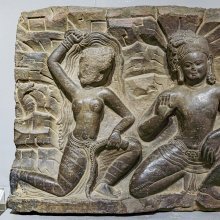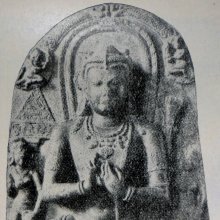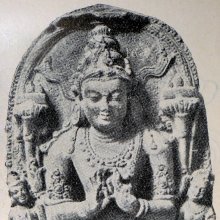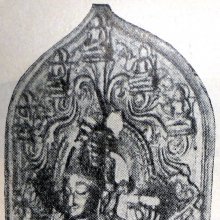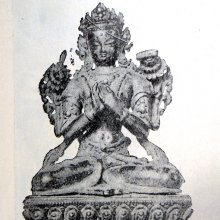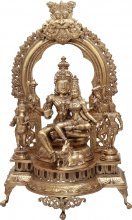Shringara, Śṛṅgāra, Shrimgara: 25 definitions
Introduction:
Shringara means something in Buddhism, Pali, Hinduism, Sanskrit, Jainism, Prakrit, Marathi. If you want to know the exact meaning, history, etymology or English translation of this term then check out the descriptions on this page. Add your comment or reference to a book if you want to contribute to this summary article.
The Sanskrit term Śṛṅgāra can be transliterated into English as Srngara or Shringara, using the IAST transliteration scheme (?).
Images (photo gallery)
In Hinduism
Natyashastra (theatrics and dramaturgy)
Source: Wisdom Library: Nāṭya-śāstraŚṛṅgāra (शृङ्गार) refers to the “erotic” sentiment (rasa). It is one of the eight rasas mentioned in the Nāṭyaśāstra 6.15. The color associated with the śṛṅgāra is light green (śyāma), and the presiding deity of of the erotic (śṛṅgāra) sentiment is Viṣṇu.
According to the Nāṭyaśāstra, “The Erotic (śṛṅgāra) Sentiment proceeds from the Durable Psychological State of love (rati), and it has as its basis (lit. soul) a bright attire; for whatever in this world is white, pure, bright and beautiful is appreciated in terms of the Durable Psychological State of love.”.
Source: archive.org: The mirror of gesture (abhinaya-darpana)Śṛṅgāra (शृङ्गार).—A type of glance (or facial expression): śṛṅgāra (love): born of great joy, in the toils of love—raising the eyebrows and looking out of the corners of the eyes. Usage: mutual glances of those who are fast bound by amorous desires.
Source: Pearls at Random Strung: Godā Stuti (natya-shastra)Śṛṅgāra (शृङ्गार).—In Sanskrit literary theory, śṛṅgāra is described as existing in two modes, vipralambha-śṛṅgāra (aestheticized love-in-separation) and saṃbhoga-śṛṅgāra (aestheticized love-in-union). Godā sings extensively in both modes in her Nācciyār Tirumoli.
Source: Shodhganga: Mankhaka a sanskrit literary genius (natya)Śṛṅgāra (शृङ्गार) or the “sentiment (rasa) of love”.—The word Śṛṅgāra originates from the term śṛṅga, which literally means a ‘horn’ that grows from the head of a bull, as a plant sprouts from the ground. Thus, it means the budding of love, at the advent of Kāmadeva or Cupid, the god of love. When a man of higher dignity has erotic dalliances, it becomes a case of Śṛṅgāra. Herein Śṛṅgāra, the heroines excluding another’s wife and a harlot, if not honestly enamoured as well as the heroes impartial are the ālambanavibhāvas, again the uddīpanavibhāvas are the moon, sandalwood ointment, the humming of bees etc. whereas, motions of the eye-brows and side-glances etc. are found to be the anubhāvas and its vyabhicāribhāvas may be anything except sternness, death, indolence and disgust. Here the sthāyibhāva or permanent mood is love. The mythologists imagine that the colour of this rasa i.e. Śṛṅgāra, is black. Its presiding deity is Viṣṇu, who in His incarnation as the amorous Kṛṣṇa was celebrated for the darkness of His colour.
Regarding Śṛṅgāra, the rasa, Bharata opines that the Śṛṅgāra is that wherein, the permanent mood is rati. Dhanañjaya holds that when a pair of young man and woman feels mutual longing due to favourable place, time, dress, sports etc., that feeling is called rati or love and this rati, being fully experienced through various graceful actions, attains the status of the sentiment called Śṛṅgāra. Viśvanātha as well as Mammaṭa is of the opinion that Śṛṅgāra is of two fold viz. Saṃbhoga (love in union) and Viparalambha (love in separation). According to Dhanañjaya, there are three divisions of it, viz. Ayoga, Viprayoga and Saṃbhoga.
Source: Shodhganga: Elements of Art and Architecture in the Trtiyakhanda of the Visnudharmottarapurana (natya)Śṛṅgāra (शृङ्गार) refers to the “erotic sentiment” and represents one of the nine kinds of Rasa (“soul of Drama”), according to the Viṣṇudharmottarapurāṇa, an ancient Sanskrit text which (being encyclopedic in nature) deals with a variety of cultural topics such as arts, architecture, music, grammar and astronomy.—Rasa or Sentiment is a very important component in poetry. The Viṣṇudharmottarapurāṇa accepts nine rasas or “sentiments in Drama”. Śṛṇgāra or the sentiment of love is very important in kāvya specially in dramas. Because, Sanskrit poetics advices to portray either śṛṇgāra or vīra as the predominant sentiment in a Sanskrit drama. It is the sentiment of love and desire where the manifestation of the activities of Kāmadeva i.e the god of love can be noticed.
In the Viṣṇudharmottarapurāṇa, two terms are used to denote the second variety of śṛṇgāra sentiment:—
- viraha and
- vipralambha
But most of the Rhetoricians of Sanskrit poetics like Mammaṭa and Viśvanāthakavirāja use the term vipralambha only.

Natyashastra (नाट्यशास्त्र, nāṭyaśāstra) refers to both the ancient Indian tradition (shastra) of performing arts, (natya—theatrics, drama, dance, music), as well as the name of a Sanskrit work dealing with these subjects. It also teaches the rules for composing Dramatic plays (nataka), construction and performance of Theater, and Poetic works (kavya).
Kavya (poetry)
Source: Shodhganga: Mankhaka a sanskrit literary geniusŚṛṅgāra (शृङ्गार) was one of the brothers of Maṅkhaka (or Maṅkha or Maṅkhuka): the author of the Śrīkaṇṭhacarita and the Maṅkhakośa.

Kavya (काव्य, kavya) refers to Sanskrit poetry, a popular ancient Indian tradition of literature. There have been many Sanskrit poets over the ages, hailing from ancient India and beyond. This topic includes mahakavya, or ‘epic poetry’ and natya, or ‘dramatic poetry’.
Purana and Itihasa (epic history)
Source: archive.org: Shiva Purana - English TranslationŚṛṅgāra (शृङ्गार) refers to the “flavour of love” which entered the hearts of Śiva and Satī, according to the Śivapurāṇa 2.2.17. Accordingly as Brahmā narrated to Nārada:—“[...] She [viz., Satī] stood smiling sweetly before Śiva who was full of love. She opened her inmost feelings through various subtle gestures that increased notions of love. Taking up these notions, gestures and feelings, the flavour of love called Śṛṅgāra entered their hearts. O celestial sage, by the advent of the flavour of love, a peculiar glow, in the usual manner of worldly sports, was manifest in them as in the star Citrā and the moon”.

The Purana (पुराण, purāṇas) refers to Sanskrit literature preserving ancient India’s vast cultural history, including historical legends, religious ceremonies, various arts and sciences. The eighteen mahapuranas total over 400,000 shlokas (metrical couplets) and date to at least several centuries BCE.
Shilpashastra (iconography)
Source: Shodhganga: Elements of Art and Architecture in the Trtiyakhanda of the Visnudharmottarapurana (shilpa)Śṛṅgāra (शृङ्गार) or “erotic sentiment” refers to one of the Nine Sentiments (citrarasa) in ancient Indian Painting (citra), according to the Viṣṇudharmottarapurāṇa, an ancient Sanskrit text which (being encyclopedic in nature) deals with a variety of cultural topics such as arts, architecture, music, grammar and astronomy.—According to the Viṣṇudharmottarapurāṇa nine kinds of sentiments [e.g., śṛṅgāra—erotic] are reflected through Paintings and these are termed as citrarasas in this work. [...] The Viṣṇudharmottarapurāṇa says that in a Painting the charming dress and ornaments with splendor and luster, expresses the erotic sentiment (śṛṅgāra). The point to be noted here is that when a poet imagines a character, he paints that character with a justifying appearance in his mind before discovering the form. [...] The Viṣṇudharmottarapurāṇa gives emphasis on charming and beautiful attire and ornaments in the projection of a picture of erotic sentiment (śṛṅgāra) which obviously points the outer appearance of a character.

Shilpashastra (शिल्पशास्त्र, śilpaśāstra) represents the ancient Indian science (shastra) of creative arts (shilpa) such as sculpture, iconography and painting. Closely related to Vastushastra (architecture), they often share the same literature.
Sports, Arts and Entertainment (wordly enjoyments)
Source: archive.org: Syainika Sastra of Rudradeva with English Translation (art)Śṛṅgāra (शृङ्गार) refers to “(the emotion of) love”, according to the Śyainika-śāstra: a Sanskrit treatise dealing with the divisions and benefits of Hunting and Hawking, written by Rājā Rudradeva (or Candradeva) in possibly the 13th century.—Accordingly, [while discussing the outlines of hawking]: “[...] When two birds fly together and one is killed, the survivor mourns pitifully. This excites the emotion of sorrow. In the king, the lover’s emotion (śṛṅgāra) is discernible in two conditions, that of enjoyment when the quarry is caught, and that of separation when it escapes. [...]”.

This section covers the skills and profiencies of the Kalas (“performing arts”) and Shastras (“sciences”) involving ancient Indian traditions of sports, games, arts, entertainment, love-making and other means of wordly enjoyments. Traditionally these topics were dealt with in Sanskrit treatises explaing the philosophy and the justification of enjoying the pleasures of the senses.
General definition (in Hinduism)
Source: academia.edu: Tessitori Collection I (hinduism)Śṛṅgāra (शृङ्गार) refers to the “love (of young ladies)”, representing one of the topics of the Vasantavilāsa by Nayacandrasūri (dealing with poetry and riddles), which is included in the collection of manuscripts at the ‘Vincenzo Joppi’ library, collected by Luigi Pio Tessitori during his visit to Rajasthan between 1914 and 1919.—The Vasantavilāsa is a concentrate of the author’s literary orientations: [...] Nayacandrasūri’s Vasantavilāsa has nothing Jain. It is secular poetry devoted to the evocation of young men (nāyaka) spring (vasanta) and young ladies’ love (yuvatī-śṛṅgāra). It is composed of stanzas in Sanskrit but even more in apabhraṃśa, in different poetic forms and metres.
In Buddhism
Tibetan Buddhism (Vajrayana or tantric Buddhism)
Source: Brill: Śaivism and the Tantric Traditions (tantric Buddhism)Śṛṅgāra (शृङ्गार) refers to “fine clothing”, according to the Nāmamantrārthāvalokinī by Vilāsavajra, which is a commentary on the Nāmasaṃgīti.—Accordingly, [while describing Ādibuddha]—“[...] He is tranquil, with the ornaments of a youth, in fine clothing (sa-śṛṅgāra), wearing about himself a many coloured garment. He has eight arms, holding at his heart with four hands the Śatasāhasrikāprajñāpāramitā divided into four parts, [and] carrying, in each of the other four hands, a sword of wisdom in the gesture of striking. [All this is to be] put in place [i.e. visualised] via the yoga of the four Buddha-thrones”.
Source: OSU Press: Cakrasamvara SamadhiŚṛṃgāra (शृंगार) or Śṛṃgārarasa refers to the “erotic emotion”, according to the Cakrasaṃvara Samādhi [i.e., Cakrasamvara Meditation] ritual often performed in combination with the Cakrasaṃvara Samādhi, which refers to the primary pūjā and sādhanā practice of Newah Mahāyāna-Vajrayāna Buddhists in Nepal.—Accordingly, “Standing on top of Mahābhairava and Kālirātrī, embracing Vajravārāhī, With both arms holding a vajra and bell, adorned by a crest of dreadlocks, Decorated by a crown of skulls, holding a half moon on top of the head, Topped by the form of the Viśva Vajra, a fierce face, horrible gigantic fangs, Possessing the emotions beginning with the erotic (śṛṃgāra—śṛṃgārādi-rasānvitaṃ), putting on a tiger skin, Wearing a garland of half a hundred human heads together, Possessing the six seals, adorned with a necklace, bracelets, Ear-rings, girdle, a crest jewel, (and) covered in ashes”.
Source: MDPI Books: The Ocean of HeroesŚṛṅgāra (शृङ्गार) refers to “sexually attractive (ornaments)”, according to the 10th-century Ḍākārṇava-tantra: one of the last Tibetan Tantric scriptures belonging to the Buddhist Saṃvara tradition consisting of 51 chapters.—Accordingly, “[Vajravārāhī holds] an adamantine knife in the right [hand] and a skull bowl in the left hand; hugs the Blessed One (Heruka) around [his] hips with [her] two shanks and loves [him]; [has] one face; [has her] hair untied; is naked; is red in color; wears a garland of hairless heads [as a necklace]; is adorned with sexually attractive ornaments (śṛṅgāra-ābharaṇa); is crowned with a string of skulls on [her] head; [...]”.

Tibetan Buddhism includes schools such as Nyingma, Kadampa, Kagyu and Gelug. Their primary canon of literature is divided in two broad categories: The Kangyur, which consists of Buddha’s words, and the Tengyur, which includes commentaries from various sources. Esotericism and tantra techniques (vajrayāna) are collected indepently.
In Jainism
General definition (in Jainism)
Source: JAINpedia: JainismŚṛṅgāra (शृङ्गार, “eroticism”) refers to the “nine sentiments” (navarasa) in poetics and dramaturgy and represents one of the topics dealt with in the Anuyogadvārasūtra : a technical treatise on analytical methods, a kind of guide to applying knowledge.—In Muni Puṇyavijaya’s words, “the Nandi which is of the form of five Jñānas serves as a mangala in the beginning of the study of the Āgamas; and the Anuyogadvāra-sūtra serves as a key to the understanding of the Āgamas”.

Jainism is an Indian religion of Dharma whose doctrine revolves around harmlessness (ahimsa) towards every living being. The two major branches (Digambara and Svetambara) of Jainism stimulate self-control (or, shramana, ‘self-reliance’) and spiritual development through a path of peace for the soul to progess to the ultimate goal.
Languages of India and abroad
Marathi-English dictionary
Source: DDSA: The Molesworth Marathi and English Dictionaryśṛṅgāra (शृंगार).—m (S) Dress and decoration; bedecked state. 2 Love, the amorous passion or sentiment as a subject of poetical description or dramatic representation. Ex. of comp. śṛṅgārakrīḍā or -līlā, śṛṅgārarasa, śṛṅgārasukha, śṛṅgāravinōda, śṛṅgāra- śāstra, śṛṅgāragṛha, śṛṅgārapriya, śṛṅgārabhāva, śṛṅgārasaṃ- bhāṣaṇa, śṛṅgāramatsara. 3 Exhibition (on the part of the female) of love by fond caresses, blandishments, and tendernesses; using wanton or soft gestures or airs. 4 The commerce of the sexes.
--- OR ---
śriṅgāra (श्रिंगार).—&c. Careless corruption, even by the educated, of śṛṅgāra.
Source: DDSA: The Aryabhusan school dictionary, Marathi-Englishśṛṅgāra (शृंगार).—m Dress and decoration. Love, the amorous sentiment as a subject of poetical description. Exhibition of love (on the part of the female) by blandishments &c.
Marathi is an Indo-European language having over 70 million native speakers people in (predominantly) Maharashtra India. Marathi, like many other Indo-Aryan languages, evolved from early forms of Prakrit, which itself is a subset of Sanskrit, one of the most ancient languages of the world.
Sanskrit dictionary
Source: DDSA: The practical Sanskrit-English dictionaryŚṛṅgāra (शृङ्गार).—[śṛṅgaṃ kāmodrekamṛcchatyanena ṛ-aṇ]
1) The sentiment of love or sexual passion, the erotic sentiment (the first of the eight or nine sentiments in poetical compositions; it is of two kinds:-saṃbhogaśṛṅgāra and vipralambhaśṛṅgāra q. q. v. v.); शृङ्गारः सखि मूर्तिमानिव मधौ मुग्धो हरिः क्रीडति (śṛṅgāraḥ sakhi mūrtimāniva madhau mugdho hariḥ krīḍati) Gītagovinda 1; (it is thus defined:-puṃsaḥ striyāṃ striyāḥ puṃsi saṃbhogaṃ prati yā spṛhā | sa śṛṅgāra iti khyātaḥ krīḍāratyādikārakaḥ || See S. D.21 also).
2) Love, passion, sexual love; शृङ्गारैकरसः स्वयं नु मदनो मासो नु पुष्पाकरः (śṛṅgāraikarasaḥ svayaṃ nu madano māso nu puṣpākaraḥ) V.1.1.
3) A dress suited to amorous interviews, an elegant dress.
4) Coition, sextual union.
5) Marks made with redlead on the body of an elephant; वर्षन्तः शममानयन्नुपल- सच्छृङ्गारलेखायुधाः (varṣantaḥ śamamānayannupala- sacchṛṅgāralekhāyudhāḥ) Śiśupālavadha 17.69.
6) A mark in general.
-ram 1 Cloves.
2) Red-lead.
3) Undried ginger.
4) A fragrant powder for the dress or body.
5) Agallochum.
Derivable forms: śṛṅgāraḥ (शृङ्गारः).
Source: Cologne Digital Sanskrit Dictionaries: Shabda-Sagara Sanskrit-English DictionaryŚṛṅgāra (शृङ्गार).—m.
(-raḥ) 1. Love, the passion or sentiment as an object of poetical description or dramatic representation. 2. Copulation, coition. 3. Marks made with red-lead on an elephant’s head and trunk by way of ornament. 4. A dress suitable for amorous purposes. n.
(-raṃ) 1. Cloves. 2. Red-lead. 3. Fragrant powder for the dress or person. 4. Ginger. 5. Agallochum. E. śṛṅga eminence, dignity, ṛ to go to or obtain, and aṇ aff.; being the chief of the poetical Rasas; or śṝ to hurt, āran Unadi aff., with num and guk augments.
Source: Cologne Digital Sanskrit Dictionaries: Benfey Sanskrit-English DictionaryŚṛṅgāra (शृङ्गार).— (from śṛṅga, cf. the next), I. m. 1. Copulation, coition, [Pañcatantra] i. [distich] 191. 2. Love, [Vikramorvaśī, (ed. Bollensen.)] [distich] 9; as an object of poetical description. 3. (m. or n.?), Elegant dress (properly, a dress for amorous purposes), [Pañcatantra] 36, 18 (cf. my transl. n. 173). 4. Marks made with red lead on an elephant’s head and trunk. 5. Mark in general, [Lassen, Anthologia Sanskritica.] 69, 5 (at the end of a comp. adj.). Ii. n. 1. Red lead. 2. Cloves. 3. Fragrant powder for the dress or person.
Source: Cologne Digital Sanskrit Dictionaries: Cappeller Sanskrit-English DictionaryŚṛṅgāra (शृङ्गार).—[adjective] fair, beautiful; [masculine] ornament, fine dress, love, sexual passion, a man’s name.
Source: Cologne Digital Sanskrit Dictionaries: Aufrecht Catalogus Catalogorum1) Śṛṅgāra (शृङ्गार) as mentioned in Aufrecht’s Catalogus Catalogorum:—son of Viśvāvarta, brother of Maṅkha. Śrīkaṇṭhacarita 3, 45.
2) Śṛṅgāra (शृङ्गार):—father of Jayadratha (Alaṃkāravimarśinī). Oxf. 210^a.
3) Śṛṅgāra (शृङ्गार):—poet. [Sūktikarṇāmṛta by Śrīdharadāsa]
4) Śṛṅgāra (शृङ्गार):—father of Jayaratha (Tantrālokaviveka) and Jayadratha q. v.
Source: Cologne Digital Sanskrit Dictionaries: Monier-Williams Sanskrit-English Dictionary1) Śṛṅgāra (शृङ्गार):—[from śṛṅga] m. ([probably] connected with śṛṅga as vṛndāra with vṛnda) love (as ‘the horned’ or ‘the strong one’ ?), sexual passion or desire or enjoyment, [Kāvya literature; Rājataraṅgiṇī] etc.
2) [v.s. ...] (in [rhetoric]) the erotic sentiment (one of the 8 or 10 Rasas q.v.; it has Viṣṇu for its tutelary deity and black for its colour; [according to] to most authorities it is of two kinds, viz. sambhoga, ‘mutual enjoyment’, and vipralambha, ‘deception, disappointment’, to which by some is added as third a-yoga, ‘separation’), [Bharata-nāṭya-śāstra; Daśarūpa; Sāhitya-darpaṇa] etc.
3) [v.s. ...] a dress suitable for amorous purposes, elegant dress, fine garments, finery, [Kāvya literature; Pañcatantra; Kathāsaritsāgara] etc.
4) [v.s. ...] the ornaments on an elephant ([especially] red marks on its head and trunk), [cf. Lexicographers, esp. such as amarasiṃha, halāyudha, hemacandra, etc.] (cf. -dhārin)
5) [v.s. ...] any mark, [Monier-Williams’ Sanskrit-English Dictionary]
6) [v.s. ...] (also with bhaṭṭa) Name of various persons ([especially] of a poet), [Rājataraṅgiṇī; Catalogue(s)]
7) Śṛṅgārā (शृङ्गारा):—[from śṛṅgāra > śṛṅga] f. Name of a woman, [Inscriptions]
8) Śṛṅgāra (शृङ्गार):—[from śṛṅga] n. (only [cf. Lexicographers, esp. such as amarasiṃha, halāyudha, hemacandra, etc.]) gold
9) [v.s. ...] red-lead
10) [v.s. ...] fragrant powder for the dress or person
11) [v.s. ...] cloves
12) [v.s. ...] undried ginger
13) [v.s. ...] black aloe-wood
14) [v.s. ...] mfn. handsome, pretty, dainty, fine, [Mahābhārata; Rāmāyaṇa]
Source: Cologne Digital Sanskrit Dictionaries: Yates Sanskrit-English DictionaryŚṛṅgāra (शृङ्गार):—(raḥ) 1. m. Love; copulation; ornamental marks on the elephant’s head. n. Cloves, redlead; a fragrant powder; ginger; Agallochum.
[Sanskrit to German]
Sanskrit, also spelled संस्कृतम् (saṃskṛtam), is an ancient language of India commonly seen as the grandmother of the Indo-European language family (even English!). Closely allied with Prakrit and Pali, Sanskrit is more exhaustive in both grammar and terms and has the most extensive collection of literature in the world, greatly surpassing its sister-languages Greek and Latin.
Kannada-English dictionary
Source: Alar: Kannada-English corpusŚṛṃgara (ಶೃಂಗರ):—[noun] = ಶೃಂಗಾರ [shrimgara].
--- OR ---
Śṛṃgāra (ಶೃಂಗಾರ):—
1) [noun] anything used to embellish something or someone; an ornament.
2) [noun] the fact of decorating or being decorated; ornamentation.
3) [noun] a fanciful, decorative dress, suitable for amorous purpose.
4) [noun] the attachment or relation that exists between two persons who are in love with each other.
5) [noun] sexual desire or passion.
6) [noun] red oxide of lead, Pb3O4 , derived from massicot, used in making paint, in glassmaking, etc.; minium; red lead.
7) [noun] any mark or sign.
8) [noun] the dried flower bud of the tree Eugenia aromatica, used as a pungent, fragrant spice.
9) [noun] the undried rhizome of the plant Zingiber officinale of Zingiberaceae family, used as a spice.
10) [noun] any fragrant powder for the dress or person.
11) [noun] the wood the tree Aquilaria agallocha of Thymelaeaceae family; black eagle-wood.
12) [noun] erotic sentiment.
13) [noun] the half-opened flower-sheath of a arecanut tree14) [noun] ಶೃಂಗಾರಮಾಡು [shrimgaramadu] śriṃgāra māḍu to decorate; to adorn; to ornament; to emellish; ಶೃಂಗಾರವಾಗು [shrimgaravagu] śriṃgāravāgu to be decorated ornamented, embellished.
Kannada is a Dravidian language (as opposed to the Indo-European language family) mainly spoken in the southwestern region of India.
See also (Relevant definitions)
Starts with (+93): Shrimgaraceshte, Shrimgaradrishti, Shrimgaragollu, Shrimgarajite, Shrimgaramberu, Shrimgaramgai, Shrimgaramgey, Shrimgaravadu, Shringara-bhoga, Shringara-siddhanta, Shringarabhanga, Shringarabharana, Shringarabhasa, Shringarabhashita, Shringarabhedapradipa, Shringarabhra, Shringarabhushana, Shringaracandrika, Shringaracandrodaya, Shringaracaturika.
Ends with: Chandahshringara, Chhandahshringara, Harashringara, Jyotirvedashringara, Jyotirvidashringara, Sambhogashringara, Sashringara, Sola Shringara, Sudhishringara, Sundarashringara, Sushringara, Vipralambhashringara, Viyogashringara, Yuvatishringara.
Full-text (+234): Shringararasa, Shringarayoni, Shringarabhushana, Shringaravesha, Sambhoga, Shringarabhashita, Shringaravidhi, Shringarasahaya, Shringaraka, Rati, Shringaraikarasa, Mankhaka, Harashringara, Mahapadmatavi, Shringararasashtaka, Shringararasodaya, Shringararasamandana, Shringaravati, Shringarasarasi, Shringaraprabandhadipika.
Relevant text
Search found 57 books and stories containing Shringara, Śṛṅgāra, Srngara, Śriṅgāra, Sringara, Śṛṅgārā, Shrimgara, Śṛṃgara, Śṛṅgara, Śṛngara, Srmgara, Śṛṃgāra, Śṛngāra; (plurals include: Shringaras, Śṛṅgāras, Srngaras, Śriṅgāras, Sringaras, Śṛṅgārās, Shrimgaras, Śṛṃgaras, Śṛṅgaras, Śṛngaras, Srmgaras, Śṛṃgāras, Śṛngāras). You can also click to the full overview containing English textual excerpts. Below are direct links for the most relevant articles:
Garga Samhita (English) (by Danavir Goswami)
Verse 5.20.10 < [Chapter 20 - The Liberation of Ṛbhu Muni During the Rāsa-dance Festival]
Verse 2.22.38 < [Chapter 22 - The Rāsa-dance Pastime]
Verse 2.20.4 < [Chapter 20 - The Rāsa-dance Pastime]
Malatimadhava (study) (by Jintu Moni Dutta)
Part 1.3a - Śṛṅgāra Rasa (Erotic Sentiment) < [Chapter 2 - Literary Study of the Mālatīmādhava]
Part 4.3a - Mādhurya Guṇa (sweetness) < [Chapter 2 - Literary Study of the Mālatīmādhava]
Part 1.4 - The Principal Sentiment of the Mālatīmādhava < [Chapter 2 - Literary Study of the Mālatīmādhava]
Dasarupaka (critical study) (by Anuru Ranjan Mishra)
Part 3-6 - Samavakāra rules < [Chapter 6 - Samavakāra (critical study)]
Part 15 - Conclusion < [Chapter 6 - Samavakāra (critical study)]
Part 14 - Conclusion < [Chapter 9 - Īhāmṛga (critical study)]
Sahitya-kaumudi by Baladeva Vidyabhushana (by Gaurapada Dāsa)
Text 5.4 < [Chapter 5 - Second-rate Poetry]
Text 4.27 < [Chapter 4 - First-rate Poetry]
Text 4.47 < [Chapter 4 - First-rate Poetry]
Bhajana-Rahasya (by Srila Bhaktivinoda Thakura Mahasaya)
Text 23 < [Chapter 8 - Aṣṭama-yāma-sādhana (Rātri-līlā–prema-bhajana sambhoga)]
Text 10 < [Chapter 7 - Saptama-yāma-sādhana (Pradoṣa-kālīya-bhajana–vipralambha-prema)]
Text 9 < [Chapter 8 - Aṣṭama-yāma-sādhana (Rātri-līlā–prema-bhajana sambhoga)]
Amarakoshodghatana of Kshirasvamin (study) (by A. Yamuna Devi)
Drama and the Elements of a Dramatic play < [Chapter 4 - Cultural Aspects]
Miscellaneous (2): Varieties of poison (Viṣabheda) < [Chapter 3 - Social Aspects]
Three types of Dance < [Chapter 4 - Cultural Aspects]
